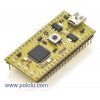



203,64 zł Netto
Płytka rozwojowa oparta na mikrokontrolerze NXP LPC11U24 umożliwia szybkie rozpoczęcie pracy z mikrokontrolerami ARM Cortex-M0 w środowisku mbed. Płytka sprawdza się w projektach edukacyjnych, prototypach systemów wbudowanych oraz aplikacjach sterujących i komunikacyjnych wymagających prostego programowania przez USB i elastycznej konfiguracji wejść oraz wyjść. Pololu 2154
Płytka rozwojowa oparta na mikrokontrolerze NXP LPC11U24 przeznaczona do nauki i prototypowania aplikacji z wykorzystaniem środowiska ARM mbed, dostępna w ofercie firmy Pololu. Układ LPC11U24 z rdzeniem ARM Cortex-M0 zapewnia energooszczędną pracę oraz wystarczającą wydajność do realizacji projektów sterujących, komunikacyjnych i edukacyjnych. Wbudowany interfejs USB umożliwia programowanie płytki bez użycia zewnętrznych programatorów, a także realizację funkcji urządzenia USB w tworzonych aplikacjach. Płytka oferuje wyprowadzone linie GPIO, interfejsy komunikacyjne oraz zgodność z ekosystemem ARM mbed, co ułatwia szybkie uruchomienie projektów i integrację z czujnikami oraz modułami zewnętrznymi.
Producent BTC Korporacja sp. z o. o. Lwowska 5 05-120 Legionowo Polska sprzedaz@kamami.pl 22 767 36 20
Osoba odpowiedzialna BTC Korporacja sp. z o. o. Lwowska 5 05-120 Legionowo Polska sprzedaz@kamami.pl 22 767 36 20
Moduł rozszerzeń z czujnikami ruchu (9-osiowy). Moduł łączy dwa układy scalone: 3-osiowy żyroskop FXAS21002C oraz 6-osiowy akcelerometr/magnetometr FXOS8700CQ. Płytka wyposażona jest w złącza kompatybilne z Arduino UNO R3. NXP FRDM-STBC-AGM01
IMXRT1050-EVKB to zestaw ewaluacyjny od NXP z procesorem i.MX RT1050 ARM Cortex-M7 600 MHz, 256 MB pamięci SDRAM, złącze USB Host oraz OTG, złącze Ethernet oraz slot na kartę SD. IMXRT1050-EVKB
Moduł z wyświetlaczem LCD 4,3-cale przeznaczony do użycia z zestawami uruchomieniowymi firmy Freescale. Jest częścią systemu Freescale Tower. LCD TWR-LCD-RGB
Zestaw ewaluacyjny 8MMINILPD4-EVKB to kompletna platforma do projektowania i testowania aplikacji opartych na procesorach i.MX 8M Mini, z bogatym zestawem interfejsów i gotowym modułem komunikacyjnym.
Zestaw ewaluacyjny z czterordzeniowym procesorem i.MX 8M Nano, 2GB RAM DDR4 i 16GB pamięci eMMC 5.0/5.1. Wyposażony w moduł Wi-Fi 802.11a/b/g/n/ac i Bluetooth 4.1, złącze MIPI-CSI oraz MIPI-DSI, audio Jack 3,5 mm, USB 3.0 oraz Ethernet. NXP 8MNANOD4-EVK
QN9080-DK to zestaw rozwojowy z układem QN9080 BLE SOC firmy NXP. Układ ten posiada zintegrowany 32-bitowy rdzeń ARM Cortex-M4F oraz układ do łączności Bluetooth (BLE v5.0). W zestawie oprócz płytki z układem QN9080 znajduje się dongle USB (również z układem QN9080) co pozwala na realizację komunikacji master/slave między dwoma układami QN9080. QN9080-DK
NXP MRB-KW019032EU to modułowy zestaw oparty na 32-bitowym mikrokontrolerze z rdzeniem ARM Cortex M0 48 MHz, wyposażona w moduł radiowy 868 MHz. MRB-KW019032EU
Zestaw ewaluacyjny z dwurdzeniowym układem MIMXRT1176DVMAA, który działa z prędkością do 1 GHz, ma 512 Mb pamięci SDRAM, 512 Mb Flash oraz 128 Mb QSPI Flash. NXP MIMXRT1170-EVK
Brak towaru
Zestaw demonstracyjny i programistyczny dla tagów NFC. Zaprojektowany do emulacji za pomocą układu tagów NTAG I²C plus w systemach wbudowanych. NXP NTAG I2C Plus Explorer Kit
Zestaw ewaluacyjny z 4-rdzeniowym procesorem aplikacyjnym i.MX 8M Mini. Zestaw wyposażony jest w moduł WiFi i Bluetooth 4.1 oraz posiada złącza Ethernet, USB 3.0 i interfejs PCIe M.2. NXP 8MMINID4-EVK
Zestaw rozwojowy zawierający moduł A71CH Plug&Trust, umożliwiający łatwe i szybkie tworzenie bezpiecznych aplikacji IoT. NXP OM3710/A71CHARD
Brak towaru
Płytka rozwojowa oparta na procesorze z dwoma rdzeniami Cortex-A55 i wspomagającym Cortex-M33, z wbudowanym mikroakceleratorem AI Arm Ethos-U65 do lokalnego przetwarzania danych. Oferuje bogaty zestaw interfejsów (HDMI, MIPI DSI/CSI-2, USB, Ethernet, CAN), łączność bezprzewodową (Wi-Fi 6, Bluetooth 5.4, Thread/Zigbee) oraz pamięć 2 GB LPDDR4X i 32 GB eMMC, umożliwiając szybkie tworzenie zaawansowanych aplikacji IoT i edge AI. Obsługa Linux i FreeRTOS, funkcje bezpieczeństwa EdgeLock®, platforma GoPoint i rozszerzalna architektura czynią ją kompletnym narzędziem do prototypowania i wdrożeń. NXP FRDM-IMX93
OM2NTA5332 to zaawansowane narzędzie do rozbudowy układów interfejsu od NXP Semiconductors, idealne dla inżynierów i projektantów rozwijających oraz testujących różne interfejsy w układach elektronicznych. Umożliwia łatwą integrację z różnymi protokołami komunikacyjnymi, co czyni je wszechstronnym rozwiązaniem do systemów wbudowanych, IoT i innych aplikacji wymagających elastyczności i skalowalności.
Zestaw ewaluacyjny i.MX RT1050, Cortex-M7, częstotliwość 600 MHz, 256 MB SRAM, 512 MB Flash
Moduł wyprodukowany przez firmę NGX Technologies przeznaczony do użycia z modułami LPC1788, LPC185x, LPC435x Xplorer++. Został wyposażony w m.in. wyświetlacz LCD, cztery złącze interfejsu RS232, potencjometr, diody LED oraz przyciski do dyspozycji użytkownika.
Moduł Freescale TWR-ELEV stanowi kluczowy element systemu Tower, umożliwiający łączenie i zasilanie modułów mikrokontrolerowych oraz peryferyjnych. Zapewnia pełną funkcjonalność komunikacyjną i mechaniczną, stanowiąc bazę dla rozwoju oraz testowania systemów opartych na mikrokontrolerach Freescale/NXP.
Brak towaru

Płytka rozwojowa oparta na mikrokontrolerze NXP LPC11U24 umożliwia szybkie rozpoczęcie pracy z mikrokontrolerami ARM Cortex-M0 w środowisku mbed. Płytka sprawdza się w projektach edukacyjnych, prototypach systemów wbudowanych oraz aplikacjach sterujących i komunikacyjnych wymagających prostego programowania przez USB i elastycznej konfiguracji wejść oraz wyjść. Pololu 2154
